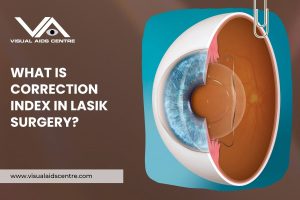Table of Contents
ToggleBefore undergoing LASIK surgery, thorough pre-operative tests are conducted to ensure you’re an ideal candidate for the procedure.
These tests assess the health of your eyes, measure their exact specifications, and determine your suitability for safe and effective vision correction.
Comprehensive Eye Examination
The first and most critical step before LASIK is a comprehensive eye exam. This involves:
- Vision Assessment
Your eye doctor will evaluate your current vision using a standard eye chart to determine your prescription. They assess how well you see both near and far, which helps identify your refractive error, such as myopia (nearsightedness), hyperopia (farsightedness), or astigmatism.
- Eye Health Check
A detailed inspection of your eyes is done to ensure they are free from infections, injuries, or abnormalities. The ophthalmologist carefully examines your cornea, retina, and optic nerve for any issues that could complicate the LASIK procedure.
- Dry Eye Diagnosis
Dry eye syndrome is one of the key factors doctors check for because LASIK can temporarily exacerbate dry eyes. A tear film test is often conducted to evaluate the quality and quantity of tears your eyes produce. Managing dryness before the procedure is critical for comfort and healing.
Corneal Thickness Measurement
One of the most vital tests before LASIK is measuring the thickness of your cornea, as it plays a significant role in the surgery’s safety. LASIK involves reshaping the cornea, and adequate thickness is required to avoid complications.
- Pachymetry Test
A pachymeter is used to measure corneal thickness. If the cornea is too thin, alternative treatments like PRK (Photorefractive Keratectomy) might be recommended instead of LASIK.
Why it matters?: If not enough corneal tissue remains after LASIK reshaping, it can lead to instability of the cornea and impact long-term vision outcomes.
Corneal Topography
Corneal topography creates a detailed map of the cornea’s surface, capturing its shape, curvature, and any irregularities.
- Detecting Keratoconus
This test helps identify abnormal corneal conditions like keratoconus (a thinning and bulging of the cornea), which rules out LASIK eligibility.
- Ensuring Optimal Results
The data from corneal topography guides the laser in reshaping your cornea accurately during the procedure.
Why it’s important?: A highly accurate map ensures the surgeon can plan the treatment with precision, leading to better correction and long-term stability.
Pupil Size Measurement
Your pupil’s size is another important factor checked before LASIK. Pupil dilation and measurement determine how your eyes adapt to light and dark environments.
- Dark Environment Check
Larger pupils in dim lighting may lead to issues like glare or halos post-surgery. The test evaluates nighttime pupil size to predict and minimise such side effects.
Benefit to you: Measuring pupil size ensures the treatment zone generated by the laser will adequately cover your pupil for seamless vision.
Wavefront Analysis
Modern LASIK procedures use wavefront-guided technology to personalise treatment. During a wavefront analysis, a map of how light travels through your eye is created.
- Aberration Detection
It identifies higher-order aberrations (minute optical imperfections) that may cause glare, halos, or difficulty seeing at night.
- Custom Treatment Plan
By incorporating the data from this test, LASIK treatment becomes more individualised, addressing unique challenges in your eye’s anatomy.
Why it’s important?: Wavefront analysis ensures your vision correction is tailored for maximum accuracy and improved outcomes.
Refraction Assessment
Your eye’s refractive error is measured to determine the degree of correction needed.
- Manual Refraction
With the help of lenses and an optical device called a phoropter, the doctor identifies your exact prescription for glasses or contact lenses.
- Autorefractor Test
A computerised test gives an initial estimate of your refractive error, which is fine-tuned for greater precision through the manual inspection.
Why it’s essential?: Understanding your refractive error forms the foundation of laser calibration during LASIK.
Dilated Eye Exam
Eye drops are used to dilate your pupils, allowing the doctor to examine the retina, optic nerve, and interior parts of your eye comprehensively.
- Evaluating Retina Health
Conditions like retinal tears or detachment need to be addressed before LASIK to prevent complications.
- Spotting Hidden Issues
Dilation helps the doctor identify less obvious conditions such as glaucoma or macular degeneration.
Key takeaway: A dilated exam ensures there are no underlying issues that could affect the safety of your LASIK procedure.
Cycloplegic Refraction Test
This test prevents your eyes from accommodating (focusing), revealing your true refractive error.
- Eye Drops Application
Cycloplegic eye drops temporarily paralyse the focusing muscles in your eyes to eliminate any interference during testing.
- Precise Measurements
It allows the doctor to measure your refractive error without the influence of your eye’s focusing mechanisms.
Why it matters?: Cycloplegic refraction provides the most accurate assessment for LASIK success.
Pressure Test (Tonometry)
To ensure no underlying conditions like glaucoma, your eye pressure is measured.
- Non-Contact Tonometry
This uses a puff of air to check intraocular pressure.
- Goldmann Applanation
A more advanced method using a device to gently touch the eye (anaesthetic drops are used for comfort).
How it helps?: Eye pressure tests rule out potential complications that could make LASIK risky.
Medical History Review
Your medical history plays a crucial role in the overall evaluation.
- Systemic Conditions
Diseases like uncontrolled diabetes or autoimmune disorders can impact healing and LASIK results. The doctor will discuss your history, existing medications, and any allergies.
- Pregnancy/Nursing
Pregnancy hormones may temporarily affect vision. Women who are pregnant or nursing are often advised to postpone LASIK until hormone levels stabilise.
Contact Lens Rule-Out Period
If you’re a contact lens wearer, your eye doctor will ask you to stop wearing contacts for a period before your pre-LASIK evaluations, as they can temporarily reshape your cornea.
- Soft Contacts: 2 weeks
- Hard/Gas Permeable Contacts: 3-4 weeks
Why it’s important?: Adhering to the no-contact-lens period ensures all tests accurately reflect your natural corneal shape.
Final Thoughts
The pre-operative tests for LASIK are crucial for personalised treatment, safety, and optimal results. Each test not only determines your suitability for LASIK but also helps fine-tune the procedure for your specific needs, ensuring exceptional accuracy and vision correction. Failing to undergo these evaluations could lead to subpar results or complications.
Considering LASIK?
Your first step is a consultation with an experienced ophthalmologist. These extensive tests will provide you with all the answers you need to make an informed decision about your vision correction surgery. Take the leap and discover a brighter, sharper world!













